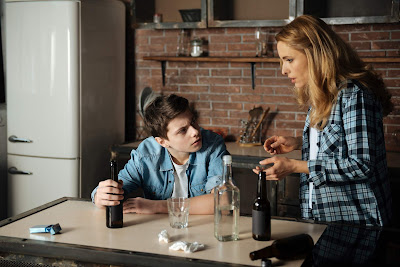Does ecstasy really contain crushed-up glass?
.jpg) I received a couple of emails from readers of my latest blog entry that dealt with the issue of possible 'adulterants' in LSD asking the question "what do manufacturers of illicit drugs actually put into their product and how harmful could these be?"
I received a couple of emails from readers of my latest blog entry that dealt with the issue of possible 'adulterants' in LSD asking the question "what do manufacturers of illicit drugs actually put into their product and how harmful could these be?"Many people, including many drug users themselves, believe that illegal drugs can often be 'cut' with a variety of different dangerous substances. These can range from products found in the laundry cupboard, such as washing-up powder and bleach, through to rat poison, kitty litter and crushed-up glass. There is also the belief that sometimes, other more dangerous illicit drugs are added, either to add to the effect or to get the unsuspecting user 'hooked' on the other substance. This is particularly true when it comes to ecstasy, with many users believing that some pills contain heroin (often referred to as 'smacky E's'). Cannabis users will often talk of hearing that the plant is 'laced' with other substances (in recent years I have been asked by young people, users and workers alike whether there is evidence to suggest that cannabis is sprayed with heroin, amphetamine and even ketamine!).
In actual fact, there is little evidence to support either of these beliefs. Before we look into the facts behind these myths, it is important to examine why these beliefs may exist in the first place.
Firstly, due to the information that we often provide to the community about illegal drugs in regards to the way they are made, it is commonly believed that little care is taken during the manufacturing process. We tell young people that drugs such as speed and ecstasy are manufactured in 'backyard laboratories' and, as a result, that any products could be used in the mix. Secondly, we constantly reinforce the fact that people involved in the manufacture and supply of drugs are believed to be capable of just about anything and so it seems reasonable to believe that they would do incredibly irresponsible things like this.
In reality, this is not always the case and to be quite truthful, if manufacturers did start to include things like rat poison in their mix, we would very quickly see the results and they would start to lose business! Although the labs used to make illicit drugs are not the same quality as those used by pharmaceutical companies, it is highly unlikely that the chemists have boxes of rat poison hanging around that could accidentally fall into the mix. Without a doubt, organized crime is unscrupulous when it comes to increasing profits and they're not really going to care about the misery that their products could inflict on the users. However, one thing everyone needs to remember is that the manufacturers and dealers want return business. If they were making and selling products that contained some of the things that are often discussed, their business would dry up fairly quickly.
Drugs that are seized by police are routinely tested both here and internationally. There is a great deal of forensic evidence available and many of the substances often discussed have never been found. Drugs definitely have things added to them to improve profit margins, but usually these products are fairly benign and may include paracetamol, caffeine, glucose, lactose and other sugars. Bicarbonate of soda and Epsom salts are also sometimes found. Of course, if you're talking about pills and tablets, a variety of starch and gums are also used to bind the drug together.
Unfortunately sometimes urban myths like this are picked up by people who should know better and results in media reports and a wider belief that there is some basis in fact behind it.
Many years ago a story ran in many newspapers across the country about ecstasy being tested and crushed-up glass being found as a result. The story originated from a politician who had issued a press release warning about the possible dangers. As you can imagine this received huge attention and I was asked to make comment on what I thought about this discovery. I was quite surprised by the story and before I was willing to make a comment to the media I contacted the politician's media officer. When I spoke to him I asked him where the information had come from as I was very surprised that I had not heard of such results before. There was a lot of mumbling and fumbling on the other side of the phone and after a while he said he would have to get back to me with his source.
Finally I got a phone call from a very junior member of staff who told me that the information from the press release had originated from a well-known south-east Asian newspaper. Someone had read an article whilst on holiday that discussed crushed-up glass being found in ecstasy pills and had brought it back to Australia. There had been no effort made to verify if there was any truth to the story, they just put the information into the press release and the rest is history. When I made a follow-up phone call to express my concern about the story an hour or two later I was told by a more senior staff member that the phone call I had received never happened! They knew nothing about a "south-east Asian newspaper story" ...
To this day I still get questions about glass being found in ecstasy. The myth has been around for years and there is no evidence to support it. The story even attempts to explain why glass would be used, i.e., to make tiny cuts in the stomach to enable the ecstasy to enter the bloodstream faster, enabling the user to experience the effect of the drug in less time. Really!!! Also, it is also important to remember what 'crushed-up glass' actually is - that's right, it's sand! After discussions with others in the field, including some toxicologists, there is the belief that this is where this myth may have originated - testing was conducted at one time or another and sand was found in a batch of pills. When the results were written up and issued to the public, to make it more sensational - 'sand' was changed to 'crushed-up glass' ... I don't think we'll ever know if this is truly where this myth came from but I think it's a pretty good guess!
Is it any wonder that young people do not heed the warnings we give them about illicit drugs when even our government issues press releases based on media reports and no available evidence? You keep crying 'wolf' and sadly, when there is an important message to get out there (e.g., there appears to be a highly risky product currently being sold as LSD in this country) , there is no way in the world young people are going to believe a word we say!
When it comes to lacing drugs with other illicit substances in an attempt to entice young naïve users to start using them, it is important to consider one important thing – the cost. Drugs are expensive and it just doesn't make any economical sense for drug manufacturers or suppliers to add other costly substances to their products, in the hope that the unsuspecting user may get hooked onto it at some stage in the future.
It’s also important to remember that once again, drugs are routinely tested and if some of these substances had been discovered we would know about it fairly fast.
My greatest concern about this myth is that it diverts attention from the very real issue that the drug the user intended to buy may itself be dangerous. One of my pet hates is when you hear the police talking about a 'bad batch' of drugs currently available on the streets. The problem with this is that it implies that there are 'good batches' available. Talking about adulterants, whether they be legally available products or illegal substances, reinforces the myth amongst drug users that the only real harm associated with their dug of choice relates to issues of purity. All drugs are risky and although the harms are different for different drugs, for different people, they are real and our young people need to be aware of them.
It is important to let young people know that there is no way of being certain what is in any illicit substance – no matter what anyone says. Stories about drugs containing all types of weird and wonderful things such as rat poison and kitty litter are just that – stories. We need to make sure that we don't get carried away worrying about potentially dangerous adulterants that could have been added to the mix. When we do that we lose sight of the incredibly important message that what they are intending to buy holds a certain degree of risk itself.



Thank you for writing this article. "Anti-drug warriors" need to learn that if they keep lying and spreading bullshit rumours they will just lose the last remnants of credibility. The "glass" story was repeated to me by a nurse and I couldn't persuade her it was an urban legend. A nurse!
ReplyDelete